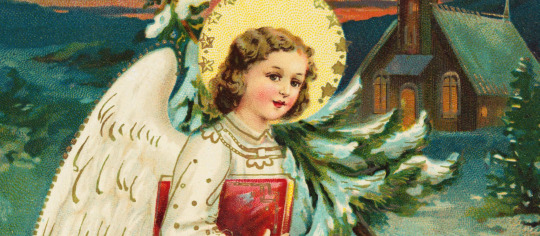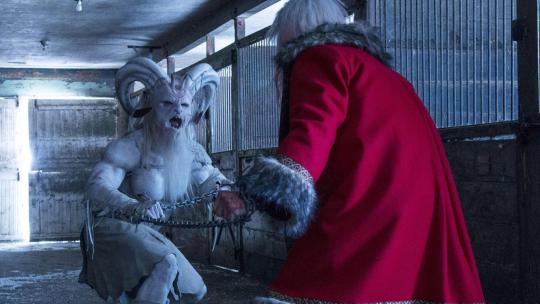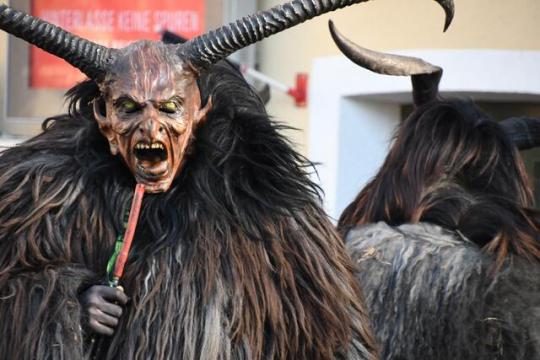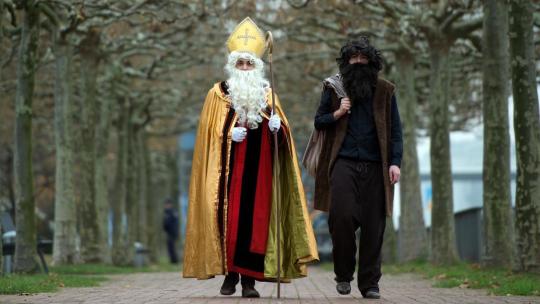#servent rubart
Explore tagged Tumblr posts
Text
On Santa, the Christkindle, Krampus and Frau Holle

Let me tell you Americans something – because I know that most people on this specific hellsite are in fact American, while I am not. I am European. German, to be exact, with some Asian roots, according to my mother. And a few days in a rather useless attempt to get a bit into the Holiday spirit, I watched the movie “Red One”. An American friend already noted, how he was aware that in the finale of the movie, it does not make a lot of sense to save Christmas, given not everyone celebrates Christmas around the world, and how also a couple of countries have the presents out on January, 6th, on the Epiphany. Which, yes, is true.
When I watched the movie, though, and got to the place, I messaged that friend: “By the way, do you know that Santa does in fact not bring us the presents in Germany? Or most of Europe, in fact. Oh, and also, Krampus is in fact not really the Anti-Santa or Santa’s brother or some shit, but that goes back a whole lot further than just Christianity.”
On the next day, though, I could not help it, but think about the entire thing. Because I was not quite sure whether I had some cognitive bias about Krampus – or if my gut feeling was right. And that got me down a long, long rabbit hole.
So, my dear Americans, let me regail you with Christmas stories from Europe, and why Krampus has more to do with white men being butthurt than anything else. Alright? Alright!
Christkindelein, Christkindelein

Now, I will not go too deeply into the entire Santa thing. Just know: Yes, St. Nikolaus is in fact connected to Christmas traditions all over Europe. However, in quite a lot of European countries, like in Germany, St. Nikolaus only comes on December 6th, where he will bring a bit of chocolate, and maybe some socks. No big presents. Those are for Christmas.
So, why does Nikolaus come on December 6th? Well, this has to do with Saints’ Days in the Catholic calendar. Basically: Every saint in the Catholic canon has a day dedicated to them. And yes, we have more than 365 saints, so yes, several saints will usually share a day. St. Nikolaus, the Turkish bishop, has his day on December 6th, hence this is the day when someone dressed as a somewhat more historical St. Nikolaus will appear in German kindergardens and schools. And also in some other countries. (Not all countries celebrate this.) That will usually look something like this.
Now, Germany will have the presents on Christmas Eve. Not on the morning of December 25th, but the tradition was originally for the family to go to Christmas (like a literal mas) on the evening of December 24th, and then come home for a good feast and presents, because the presents had been “delivered” while the family was in the church. But no, they were not delivered by St. Nick, but by the Christkind, the Christ Child. And generally speaking in most of the Catholic areas of Europe it tends to be either the Christ Child who delivers the presents, or the Magi – in those areas of Europe where the presents get to the kids on Epiphany.
And yes, there are absolutely a lot of families in Europe today, who have not a strong religious tradition, and hence just use Santa, because American Imperialism is a thing, and most movies the kids are aware off use Santa. After all those families will usually not go to Church for the literal Christmas and… Well, what difference does it make.
However, I should not that it is generally not a thing over here – even in those families that were taken in by American Imperialism – to put out cookies and milk for Santa. That very much is an American thing. Please, dear Americans, just do not assume that something that is a traditions with you folks gets done the same everywhere on the world. Because in fact, very few things Americans celebrate are celebrated the same way anywhere else (outside of Canada, I guess).
But this is actually the less interesting part of this little essay.
No, I actually wanted to talk with you about Krampus.
Krampus is not Santa’s Brother

Now I will tell you something, that has surprised all my American friends: I never heard of Krampus until I was 18. Never once was I aware that Krampus was a thing that existed, despite me being from Germany. Shocking, right?
Because here is the thing: Krampus does not originate in Germany, but in Austria. And specifically the Krampus tradition originates in Styria. Which once more is the moment I will remind my dear Castlevania fans that: Yes, indeed. Styria is a real place. It is a region within Austria. And to be exact it is the region in Europe that was Christianized the latest. (Please mind: Yes, there were other region that were not-majority Christian later, but those got Christianized before, but were taken over by Muslims afterwards. Meanwhile Styria was only Christianized majorly in the 12th century. Mainly because it is an area that is so high up in the mountains, that pretty much everyone until then who tried to forcefully Christianize failed.)
And when I was 18, I moved in with my then boyfriend, who lived in Leoben in Styria. So that year was the first time, that I ever heard of Krampus, because there was a lot of Krampus related stuff happening in Styria. Mainly there was a Krampuslauf pretty much everywhere on December 5th, so in the night before December 6th, before St. Nikolaus came. And yes, as you might be aware, the story about Krampus is usually about how he will take the naughty children and kidnap and eat them in some way or form.
In Austria meanwhile this looks like this: A whole lot of men dress up with creepy masks, run through the streets, and hit people with whips. A very Castlevania holiday indeed. Yes, usually some bullshit happens, because of people are anonymous some bullshit always happens, right?
And for my whole life I have always wondered: While I was living in Austria I noticed a whole lot more references to Krampus in American media. I chucked it up to be a cognitive bias. You know, when you learn about a new word for example, you notice it a lot more being used. So I shrugged and went on with my life, not really thinking about this again. Until that conversation a couple of days ago. And this time… This time I could not help myself. Because I was like: “I am pretty sure the Krampus tradition is older than the St. Nikolaus tradition in that area. So it is probably not a Christian thing.” But I also kept thinking: “Is it though?” Mainly, because during this years @fluff-cember I also wrote a story about Perchten, and I could not help but notice one thing: Krampus has an awful lot of similarity to Perchten.
Mother Holde and Perchten

Hey, you. Americans specifically. Do you know the story of Frau Holle? Because while I know you might probably not be familiar with a lot of European folklore, there is a good chance you at least will know the fairytale by the Brothers Grimm.
If you don’t, don’t worry. I will give you the short rundown. (Mind you, like with all fairlytales, there are about 10 different versions of this story going around. Because those were oral stories first.)
The short version however is like this.
A miller looses his wife and marries anew. And his new wife has a daughter from a previous marriage. Now they have two daughters named Marie. And like it goes in those fairytales, the stepmother treats the Marie from the old marriage very poorly, especially after the father dies. However, this Marie is a diligent child. She will do all her chores without complaining. And one day she is send to spin yarn at the local well. However, her spindle falls into the well – and when she tries to fetch it, she falls into it as well. However, instead of being stuck in the well, it turns out she gets basically isekai’d into another realm, where an old woman meets her, introducing herself as Frau Holle. And she offers this Marie to help her with her chores, and if Marie does so, she will be rewarded. Marie, being the diligent child, obviously agrees. And she does the chores, that unbeknownst to her actually allow the season on earth to move on properly. Part of it is to beat out the pillows and blankets, making it snow on the world. And after a while, Frau Holle is very impressed with her, and showers her in gold, before sending her back home. Now, the stepmother finds this child now rich and golden, and asks her where she got all that gold. And Marie, being the diligent child, tells her. So the stepmother tells her own daughter to do the same. So this daughter will also spin by the well, drop her spindle, fall in and get isekai’d. And indeed. It happens. However, this Marie is lazy and not at all diligent. And after a while Frau Holle has enough with her, and instead of with gold, she showers this Marie in pitch and sends her back.
And then there is this moral about being a diligent girl and diligence being rewarded and stuff.
However, Frau Holle actually goes far, far back into German, and especially alpine mythology to the goddess Holde, Berchte, or Perchten.
Now, we have a pretty good idea from mythological research, that Berchte (to be translated as “the bright one”) was probably very related to Frigg from Norse mythology, just with some adjustments given that this was a goddess who was prayed to in the alps, rather than Scandinavia – and mythology will always shift to reflect the area people live in.
But yes, Berchte was – from all we can reconstruct – always linked to spinning, and to the midwinter holidays. After all, most cultures did celebrate the solstices in some way or form. And it seems that indeed Berchte was connected to bringing gifts during the solstice, but also with punishing lazy and naughty children and servants. While we do have little written evidence for this in the pre-Christian culture (because they wrote down very little), we know that Berchte was said to roam around during the Christmas holidays, after these areas got Christanized.

And while Berchte would both appaear as a pretty young woman, and a motherly old woman, there seemed at some point a shift to happen. And when she came to punish those who had been lazy or naughty, she would appear as a monsterous woman with goat horns, who more commonly was called Perchten. (Still same word root though.) It is not quite clear whether Perchten at that point already was a different being from Berchte – or just a slightly varied name for a different incarnation. But however it happened: Over the next few centuries the Berchte worship died out, but Perchten survived.
Perchten and the Angry White Men

Now, here comes the interesting bit. Because we have written evidence of Perchten going as far back as the 12th century. And we know that even after Christianization of these area, Perchten stayed around. And in fact, it became a tradition for the women to dress up as Perchten during the Christmas celebrations (which back in the day lasted for 12 days, as you might know) and play tricks on everyone, who they perceived to have been naughty.
And… Well, here is the thing. We do not know how it happened. But one of the current theories is, that simply some men were like: “Why do women get to have all the fun?!” And kinda wanted to make a male pendent for Perchten. Which ended up being Krampus.
Now, please consider two things: 1) There is a theory too, that Krampus might have been influenced by Ottoman and Balkan mythology, though this connection is kinda hard to source, though it would explain the origins of the name. 2) In northern areas of the Germanic people, St. Nikolaus was already celebrated and had a companion, who was indeed punishing the naughty kids. Servant Rupert (Knecht Ruprecht). However, this companion was not monstrous like Krampus, but just a guy in a servant’s uniform and with a whip made of twigs. Simple as that. It still might have been an influence.
One way or another: Ethnologists are very, very certain that Krampus did come to be as a reaction to Perchten and the Perchtenläufe, which also explains the visual correlations between Krampus and Perchten.
The first written sources we have for Krampus showing up only go back to the mid-17th century, but historians assume that this tradition started in the late-16th century. But the exact details are fairly hard to pin down.
It turns out, though, that my very subjective experience of not noticing a whole lot of Krampus stuff earlier was very correct. Because… this tradition kinda got lost mostly during the 19th century. Like, sure, some places still had a Krampuslauf of some sort, and had Krampus come with St. Nikolaus during the celebrations, but for several reasons (one of them being that the Krampus just appeared too pagan) the tradition mostly got lost for a long, long while.
White People and their Lost Culture

And this brings me back to me never ever hearing anything about Krampus until I moved to Austria about 15 years ago. Because when I was in Austria, everyone told me that, yeah, sure, this Krampus thing is totally an old tradition. And heck, many of them might not even have meant to lie to me, given they were themselves fairly young. But indeed, the widespread comeback of the Krampuslauf actually only started in the late 1990s and early 2000s.
Again, no, it was never a fully dead tradition, but it had petered off over the centuries and only was a thing in very few places until Styria came into the problem, that a lot of western European nations generally have to struggle with: “Well, Christianity got pushed onto us during the middle ages, and we actually do not fucking know a whole lot about our culture before Christianity, do we now? So if I do no longer align with Christianity, what the heck is my culture?” This need to have a culture of their own clearly also was influenced by the influx of immigrants and the racist reflex to be like: “Hey, this is our culture” in comparison.
And so… someone stumbled across the entire Krampus thing and was like: “Welp, this certainly does feel kinda pagan, doesn’t it?” And so Krampus was brought back, and within a couple of years became a tradition pretty much every place in Styria participated in, before it even spread to other parts of Austria.
Which brings me back to being a little alpaca standing in Austria and being like: “Huh, I never heard of it.” And then seeing horror movies themed around Krampus spring up, tilt my head and wonder: “Wait, was this always a thing?”
The answer is: Nope. Nope, it wasn’t! American references to Krampus in media go only back until 2004, and actually the big push to include Krampus in western media only happened in the early 2010s. So no, it was actually no subconscious bias on my side. It was true. Krampus was actually fairly new and the reason I never noticed this before was, that it simply had not been a thing for very long, when I came to Austria – and that indeed American media only started to broadly include Krampus in the early 2010s.
Which brings me back to the most important thing this rabbit hole has taught me: It was actually not my subconscious cognitive bias! HOORAY!
So, what about St. Nikolaus?

Let me finish with this: St. Nikolaus has been a figure who has brought treats and presents to children and servants (I cannot stress the later part enough) at least since the 11th century, probably already earlier. The historical figure that inspired this tradition goes back to the 4th century, obviously, and the way St. Nikolaus has given out presents in Europe for the most part was related to the legend around the historical figure. And yes, from all we know, the tradition of giving St. Nikolaus some sort of other person who accompanies him and at times is responsible for punishing the evil kids and servants might go back at least until the 12th century. Those servants of St. Nick have had a whole lot of names in a whole lot of different areas, and talking about them all would let me write at least a small novella here.

And in a way, I am somewhat sad, that the one of the figures who somehow managed to get picked up by Americans is actually Krampus – and how very much divorced from the cultural context he originated it became.
I guess in some way it is fitting, given that of course the American version of St. Nikolaus is also very much divorced from any cultural context he once had. It is simply the thing American culture does: Divorcing things from their cultural context. I mean, I am gonna be mean here, but I am gonna bet that I know more about the bible than pretty much 95% of American Christians, given how Christianity came ot the US and is taught there to this day. Again: Fully divorced from the cultural context.
And still, I wish it would not be that way. It would at least make Holiday movies a whole lot more interesting. Be it the ones about Santa dealing with Santa actually being a brown man, or the ones about Krampus dealing with my horny boy originating from men wanting to have a horned representation as well, while running around the alps during the winter months.
#christmas#santa claus#st nikolaus#nikolaus#krampus#knecht ruprecht#servent rubart#europe#germany#austria#european culture#german culture#austrian culture#germanic mythology#norse mythology#mythology#winter solstice#presents#christmas presents#krampuslauf#perchten#berchte#frau holle#fairytale
41 notes
·
View notes